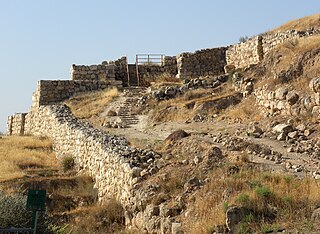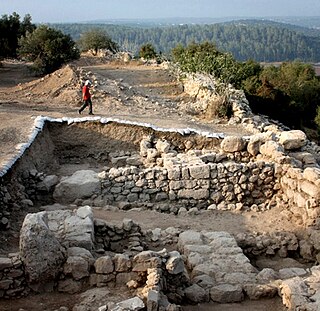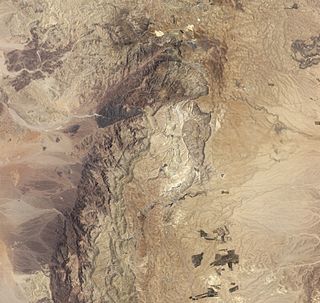Related Research Articles

Eilat is Israel's southernmost city, with a population of 52,753, a busy port and popular resort at the northern tip of the Red Sea, on what is known in Israel as the Gulf of Eilat and in Jordan as the Gulf of Aqaba. The city is considered a tourist destination for domestic and international tourists heading to Israel.

Lachish was an ancient Canaanite and Israelite city in the Shephelah region of Israel, on the south bank of the Lakhish River, mentioned several times in the Hebrew Bible. The current tell (ruin) by that name, known as Tel Lachish or Tell ed-Duweir, has been identified with the biblical Lachish. Today, it is an Israeli national park operated and maintained by the Israel Nature and Parks Authority. The park was established on lands of the depopulated Palestinian village of Qobebet Ibn ‘Awwad which was north of the Tel. It lies near the present-day moshav of Lakhish.

The Arabah, Araba or Aravah is a loosely defined geographic area in the Negev Desert, south of the Dead Sea basin, which forms part of the border between Israel to the west and Jordan to the east.

Tel Megiddo is the site of the ancient city of Megiddo, the remains of which form a tell, situated in northern Israel near Kibbutz Megiddo, about 30 km south-east of Haifa. Megiddo is known for its historical, geographical, and theological importance, especially under its Greek name Armageddon. During the Bronze Age, Megiddo was an important Canaanite city-state and during the Iron Age, a royal city in the Kingdom of Israel.

The archaeology of Israel is the study of the archaeology of the present-day Israel, stretching from prehistory through three millennia of documented history. The ancient Land of Israel was a geographical bridge between the political and cultural centers of Mesopotamia and Egypt. Despite the importance of the country to three major religions, serious archaeological research only began in the 15th century. Although he never travelled to the Levant, or even left the Netherlands, the first major work on the antiquities of Israel is considered to be Adriaan Reland's Antiquitates Sacrae veterum Hebraeorum, published in 1708. Edward Robinson, an American theologian who visited the country in 1838, published its first topographical studies. Lady Hester Stanhope performed the first modern excavation at Ashkelon in 1815. A Frenchman, Louis Felicien de Saucy, embarked on early "modern" excavations in 1850. Today, in Israel, there are some 30,000 sites of antiquity, the vast majority of which have never been excavated.

Israel Finkelstein is an Israeli archaeologist, professor emeritus at Tel Aviv University and the head of the School of Archaeology and Maritime Cultures at the University of Haifa. Finkelstein is active in the archaeology of the Levant and is an applicant of archaeological data in reconstructing biblical history. He is also known for applying the exact and life sciences in archaeological and historical reconstruction. Finkelstein is the current excavator of Megiddo, a key site for the study of the Bronze and Iron Ages in the Levant.

The Eretz Israel Museum is a historical and archeological museum in the Ramat Aviv neighborhood of Tel Aviv, Israel.

The United Monarchy is a political entity described in the deuteronomistic history of the Hebrew Bible as, under the reigns of Saul, David, and Solomon, encompassing the territories of both the later kingdoms of Judah and Israel. Whether the United Monarchy existed is a matter of ongoing academic debate, and scholars remain divided between those who support the historicity of the biblical narrative, those who doubt or dismiss it, and those who support the kingdom's theoretical existence while maintaining that the biblical narrative is exaggerated. Proponents of the kingdom's existence traditionally date it to between c. 1047 BCE and c. 930 BCE.

The Timna Valley is located in southern Israel in the southwestern Arava/Arabah, approximately 30 kilometres (19 mi) north of the Gulf of Aqaba and the city of Eilat. The area is rich in copper ore and has been mined since the 5th millennium BCE. During early antiquity, the area would have been part of the Kingdom of Edom.

Eric H. Cline is an American author, historian, archaeologist, and professor of ancient history and archaeology at The George Washington University (GWU) in Washington, D.C., where he is Professor of Classics and Anthropology and the former Chair of the Department of Classical and Near Eastern Languages and Civilizations, as well as Director of the GWU Capitol Archaeological Institute. He is also the advisor for the undergraduate archaeology majors, for which he was awarded the GWU Award for "Excellence in Undergraduate Departmental Advising" (2006). Cline served as co-editor of the Bulletin of the American Schools of Oriental Research along with Christopher Rollston from 2014–2020.

Khirbet Qeiyafa, also known as Elah Fortress and in Hebrew as Horbat Qayafa, is the site of an ancient fortress city overlooking the Elah Valley and dated to the first half of the 10th century BCE. The ruins of the fortress were uncovered in 2007, near the Israeli city of Beit Shemesh, 30 km (20 mi) from Jerusalem. It covers nearly 2.5 ha and is encircled by a 700-meter-long (2,300 ft) city wall constructed of stones weighing up to eight tons each. Excavations at site continued in subsequent years. A number of archaeologists, mainly the two excavators, Yosef Garfinkel and Saar Ganor, have claimed that it might be one of two biblical cities, either Sha'arayim, whose name they interpret as "Two Gates", because of the two gates discovered on the site, or Neta'im; and that the large structure at the center is an administrative building dating to the reign of King David, where he might have lodged at some point. This is based on their conclusions that the site dates to the early Iron IIA, ca. 1025–975 BCE, a range which includes the biblical date for the biblical Kingdom of David. Others suggest it might represent either a North Israelite, Philistine, or Canaanite fortress, a claim rejected by the archaeological team that excavated the site. The team's conclusion that Khirbet Qeiyafa was a fortress of King David has been criticised by some scholars.

Yosef Garfinkel is an Israeli archaeologist and academic. He is Professor of Prehistoric Archaeology and of Archaeology of the Biblical Period at the Hebrew University of Jerusalem.

Tel Tsaf is an archaeological site located in the central Jordan Valley, south-east of Beit She'an. It was first tested in 1978–1980 by Ram Gophna of Tel Aviv University. In 2004–2007 a large excavation project was conducted at the site by Yosef Garfinkel of the Hebrew University of Jerusalem. Since 2013 the University of Haifa and the Zinman institute of archaeology started the renewed excavation of Tel Tsaf. Tel Tsaf is dated to ca. 5200–4700 BC, sometimes called the Middle Chalcolithic, a little-known period in the archaeology of the Levant, post-dating the Wadi Rabah phase and pre-dating the Ghassulian Chalcolithic phase.

The Yarmukian culture was a Pottery Neolithic A (PNA) culture of the ancient Levant. It was the first culture in prehistoric Syria and one of the oldest in the Levant to make use of pottery. The Yarmukian derives its name from the Yarmuk River, which flows near its type site of Sha'ar HaGolan, near Kibbutz Sha'ar HaGolan at the foot of the Golan Heights. This culture existed alongside the Lodian, or Jericho IX culture and the Nizzanim culture to the south.

Edom was an ancient kingdom in Transjordan, located between Moab to the northeast, the Arabah to the west, and the Arabian Desert to the south and east. Most of its former territory is now divided between present-day southern Israel and Jordan. Edom appears in written sources relating to the late Bronze Age and to the Iron Age in the Levant.

Khirbet en-Nahas, also spelled Khirbat en-Nahas, is one of the largest copper mining and smelting sites of the ancient world, built around 3,000 years ago. It is located in Wadi Faynan, between the Dead Sea and the Gulf of Aqaba, now in Jordan. There is evidence of sophisticated economic and political activity in the valley about 3,000 years ago and archaeologists think it may be the site of an early organized state.

Ludwig Blum was a Moravian-born Israeli painter. He emigrated to Israel in 1923, as part of the Third Aliyah, and became known as "the painter of Jerusalem".

Wadi Feynan or Wadi Faynan is a major wadi and region in southern Jordan, on the border between Tafilah Governorate and Aqaba and Ma'an Governorates. It originates in the southern Jordanian Highlands with the confluence of Wadi Dana and Wadi Ghuweyr, and drains into the Dead Sea via Wadi Araba.
Matthew J. Adams is an archaeologist who specializes in the Near East. He earned his degrees at Pennsylvania State University and the University of California, Los Angeles. He served as the director of the Albright Institute of Archaeological Research in Jerusalem (2014-2022), and is the current the president of American Archaeology Abroad, Inc. He has worked on several archaeological projects in the past, and is currently director of the Jezreel Valley Regional Project, Co-Director of the Megiddo Expedition along with Israel Finkelstein and Mario Martin, and co-director of the Solomon's Pools Archaeological Project with Mark Letteney.
References
- ↑ Bohstrom, Philippe (21 November 2017). "Did David and Solomon's United Monarchy Exist? Vast Ancient Mining Operation May Hold Answers". Haaretz. Retrieved 21 November 2017.
- 1 2 "Erez Bar-Yosef". tau.ac.il. Tel Aviv University. Retrieved 21 November 2017.
- ↑ Donohue, Michelle (2 April 2017). "Found: Fresh Clues to Mystery of King Solomon's Mines". National Geographic. Retrieved 21 November 2017.